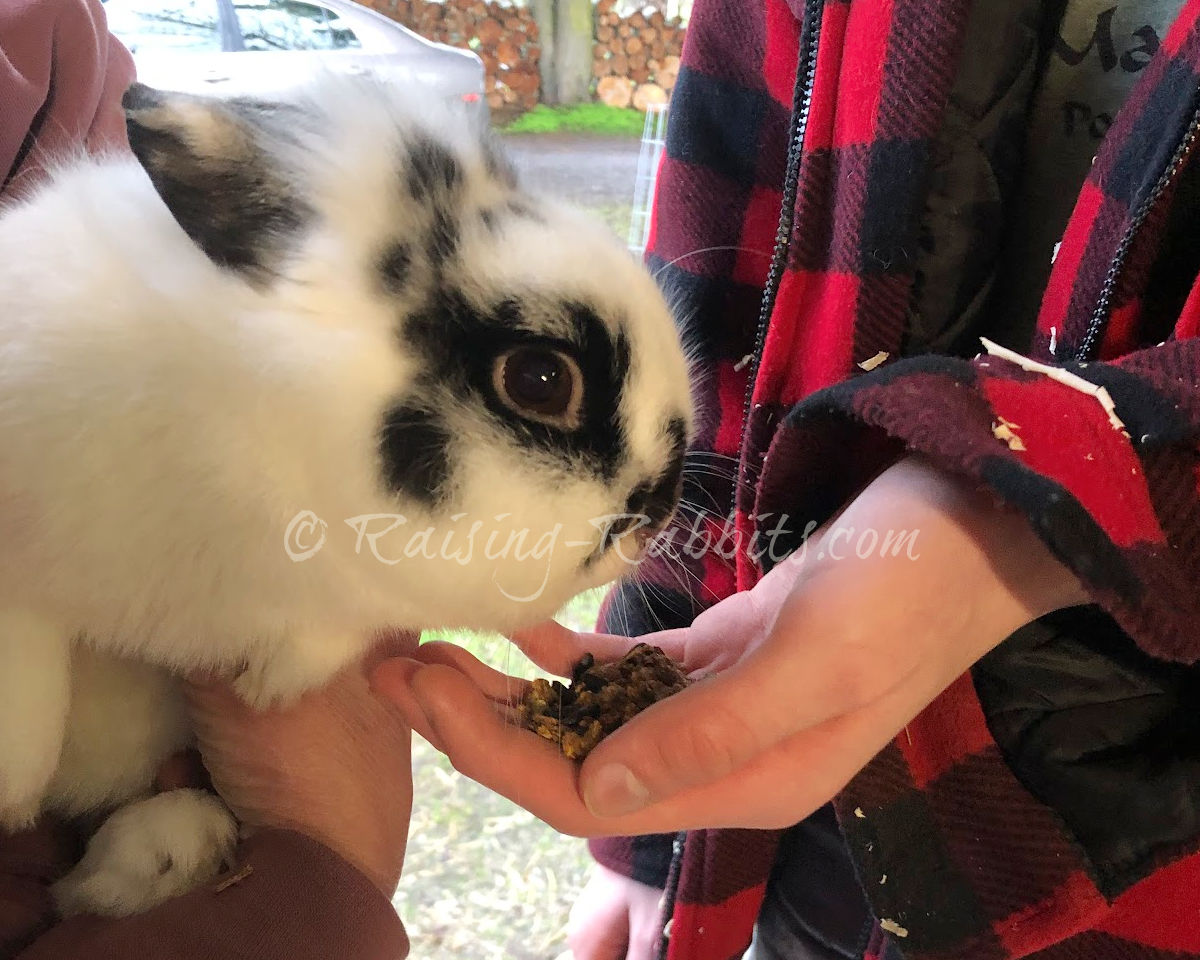More Facts about Rabbits
Facts
about Rabbits. More rabbit facts, especially about pet rabbits. Understanding your rabbit pets will help you take excellent care of your rabbits.
These EIGHT facts about pet rabbits are based upon a rabbit's underlying instincts, nature and rabbit-ness.
These facts match up with our years of experience and with scientifically conducted rabbit research. They seem to be true whether they roam your home or inhabit a hutch.
Facts about Rabbits - 1
Some house rabbits fare better with a rabbit friend. And some don’t.
Rabbits have varied personalities like people do. Being social creatures, they can and will include you in their social hierarchy. Just where you fit in will depend on the individual rabbit.
Depending on the environment you provide, the most dominant of rabbits are plenty willing to consider YOU their underling, showing little need to boss around other rabbits. And similarly, very submissive rabbits will be willing to consider you their rabbit boss.
If, however, you are a fairly busy person, then getting 2-4 altered but healthy rabbits and allowing them to form their own rabbit society is a very feasible option.
Note that even altered house rabbits may have trouble getting along with one or more of the rabbits in your home.
It is the same in a wild rabbit warren. All the rabbits in a particular warren grow up in their society knowing or soon learning what their status is. The warren will have a king and a queen rabbit couple. It will have one or two secondary dominant rabbit couples. And, it will have a number of subordinate rabbits that live on the edges of the warren scrounging whatever food and living they can find.
These are the rabbits that never seem to fit in. (But they may fit in with YOU just fine.)
Two Creative, XL-Sized Indoor Rabbit Cages. Recommended!
--Ferplast Krolik XXL Indoor Rabbit Cage with Double Extras (#ads)
Facts about Rabbits - 2
The best rabbit for a child has more
to do with a gentle personality and less to do with size.
Should kids get a big rabbit or a little one? One line of reasoning suggests that if a child receives a very large rabbit, he will not be able to pick it up, and therefore the rabbit stays safer. Which begs another question:
How safe is the rabbit if the kid can pick up only half of it? Before you know it, the rabbit’s back is broken, and the child has deep scratches up and down his or her body.
If a child receives a small rabbit, the reasoning continues, the child could easily manhandle it, possibly killing it accidentally. Apparently, according to the above arguments, a broken back is preferable to sudden death.
Actually, the choice of what size or breed of pet rabbit to obtain depends purely on yours or the child's preference. Whatever size or breed of rabbit your child acquires, safeguard the rabbit through supervision for as long as necessary.
Larger rabbits do tend to be more laid back, though plenty of smaller rabbits are gentle enough for a child. Getting a gentle rabbit, along with plenty of supervision at the outset of pet ownership (and keeping the rabbit's claws trimmed!) will help avert accidental injury either to the new pet rabbit or to the child.
Facts about Rabbits - 3
While toys may not be essential to rabbits, chewable objects help rabbits express their rabbit-ness.
It’s clear that we humans love our toys! It’s also true that some pet rabbit lovers feel bad when they see rabbits in cages. It is not true, however, to assume that rabbits love or require toys and hate being in cages, since there are vast differences in daily behaviors between humans and herbivore rabbits.
No one asks whether or not cows in the field, whether dairy or beef, need toys to play with. Cows spend the vast majority of their waking hours with their faces in the clover. This is hallmark behavior for herbivores. They graze and chew, and then graze and chew some more. Eventually, stomachs full, they drop to their bellies and watch clouds drift by as they chew their cud.
That is their whole day, and in many ways the herbivore rabbit is similar in its behavior.
According to several extensive rabbit behavior studies conducted in Europe, rabbits rest for 14 hours a day, and are active for 10 hours per day. Their active hours peak at dawn and at dusk, with the lowest activity level occurring at noon. Rabbits generally spend:
- 5 hours on grooming, scratching and stretching
- 3.5 hours on eating, drinking, and cecotrophy
- Just 5-10 minutes per day, surprisingly, gnawing on wood
- 1.5 hours
per day on exploratory and social behaviors such as sniffing, rearing up on the
hind legs, jumping, and contacting a neighbor rabbit (contact not always
reciprocated).
The lives of caged rabbits fairly closely
mirror the lives of rabbits in the wild, even if the behaviors are confined to
the space of the cage.
So, do rabbits need toys? Technically, probably not.
But why not supply a pet rabbit with objects that support its rabbit-hood, such as chewable objects?
It doesn’t matter whether or not it’s shaped like a carrot and painted orange. They may only chew on it 10 minutes a day, but at least the toy or chewable object provides the opportunity to chew.
Find some great ideas for homemade rabbit toys here.
Facts about Rabbits - 4
Rabbit introductions should be done carefully, since rabbits carry their natural societal instincts into pethood.
When rabbits meet that are unfamiliar with each other, a fight may not be automatic, but it is definitely likely.
What actually happens will depend on the personalities of the two rabbits. Are they both dominant personalities? Or is one or both of them submissive in nature?
Fights establish, or reestablish, each rabbit’s place in a societal hierarchy. In order to live peaceably together, the contest must be settled successfully in the minds of both rabbits, and the loser must follow rabbit etiquette and not challenge the dominance of the winning rabbit.
Two unaltered bucks will nearly always
brawl, possibly to the death, if one of them doesn’t quickly give up and flee
for its life. Altering a male rabbit is likely to mellow it into subservience,
but this is not a guaranteed result if the rabbit is naturally a strongly
dominant animal.
Facts about Rabbits - 5
Rabbits need to gnaw on stuff in order to keep their teeth worn down.
The grinding action of the top teeth against the lower teeth is what keeps the teeth at ideal lengths.
Please don’t assume that eating hay all day long will solve all teeth problems. What rabbits need on a regular basis is to be chewing and gnawing...on something. Hay certainly provides a partial solution. So does cage wire, cardboard, wood shavings, tree branches, 2x4s, the legs of your dining room table, etc.
And by the way, commercial pellets are not the enemy, when compounded well.
The rabbit’s gnawing action on the hay fibers
in commercial feed may be sufficient for wearing down rabbits’ teeth, IF those pieces are ground coarsely. It
doesn’t hurt to give your pet rabbits a handful of hay a day, of course. Rabbits appear to enjoy eating it, and the hay also serves as enrichment to
their environment as well as providing added insurance against diarrhea.
Notes:
- Eating too much fiber can cause a potentially fatal intestinal stasis (stoppage).
- Adult-onset malocclusion may be rooted, not in a deficiency of hay, but in a deficiency of fats and Vitamin D resulting in soft bones around the teeth. Avoid this problem not with hay but with small amounts of whole grains or oil seeds.
Facts about Rabbits - 6
A mishandled rabbit can kick hard enough to break their own back, however a well-socialized rabbit is likely to happily tolerate handling.
Rabbits don’t “usually” kick and scratch upon getting picked up, but the potential is certainly there if the rabbit is irritable, mean, sick, feral, or not adequately socialized. More than one rabbit has died from a back that was broken from an awkward or startled lift, or even from startling in its cage from a frightening sight or sound.
Some groups, especially rescue groups, tend to encounter only the rabbits that people can no longer handle for one or more of the above reasons, and soon get the sense that ALL rabbits will automatically kick and scratch when getting picked up.
It's not so. Honest. Thankfully, healthy and happy pet rabbits like
to be with their owners and usually enjoy being picked up and carried, even if for not-too-long periods at a stretch.
Black Oil Sunflower Seeds - For Extra Nutritional Support
-- 25lb Black Oil Sunflower Seeds (ad)
Facts about Rabbits - 7
Rabbits are trainable to a significant degree.
But face it: Realistically speaking, rabbits are not as intelligent as your dog (or even your cat, possibly). But this does not mean your pet rabbit only sits like a brick in a cage.
- Your pet can be litter box trained. But, due
to a tendency to randomly drop fecal pellets wherever it happens to be, we
recommend that you utilize a system of litter boxes, one for every room or
every couple rooms that your rabbit is allowed to roam. You may still need to
sweep up a pellet here or there, but once trained, the vast majority will hit the litter
boxes...we think!
- Rabbits can learn to play games like Follow the
Leader, Hide and Seek, and Rabbit Jumping. The use of a clicker with food
rewards are helpful in training your rabbits. This is the method used by
organizations such as zoos. Visit www.clickerbunny.com to learn how to use a clicker.
- I don't know of any search-and-rescue bunnies...
Check out this Cute Bunny Jumping Competition in the UK!
Facts about Rabbits - 8
One year in a rabbit’s life equals something like 9 human-years.
Pet rabbit owners can consider their rabbits fortunate if they live to be 10 years old. More than a few rabbits DO live to age 10 or even beyond, but a lifespan of 5–8 years old is much more common.
We’ve heard stories (granted, a very FEW stories) of rabbits living to be 15-17 years old.
This would be like
your great-grandmother living to be 159.
We hope these 8 facts about rabbits will help you best enjoy your pet rabbits.
Go from More Facts about Rabbits to Rabbit Facts
American Rabbit Breeders Association
Double-Value Guarantee
Our policy is to always OVER-deliver
on value,
which is why your purchase is fully covered by our
Double-Value
Guarantee.
Go ahead - take any of our e-books for a test drive. Peruse our detailed informational and educational e-books. Examine our plans for building rabbit cages, runs, or metal or PVC hutch frames. Check out the Rabbit Husbandry info e-books.
If you aren't completely satisfied that your e-book purchase is worth at least double, triple or even quadruple the price you paid, just drop us a note within 45 days, and we'll refund you the entire cost. That's our Double-Value Guarantee.
Note: When you purchase your
e-books, they will be in PDF format, so you can download them to any device that
supports PDF format. We advise making a back-up copy to a drive or cloud
account. If the books are lost, you can also purchase another copy from Raising-Rabbits.













New! Comments
Have your say about what you just read! Leave me a comment in the box below.